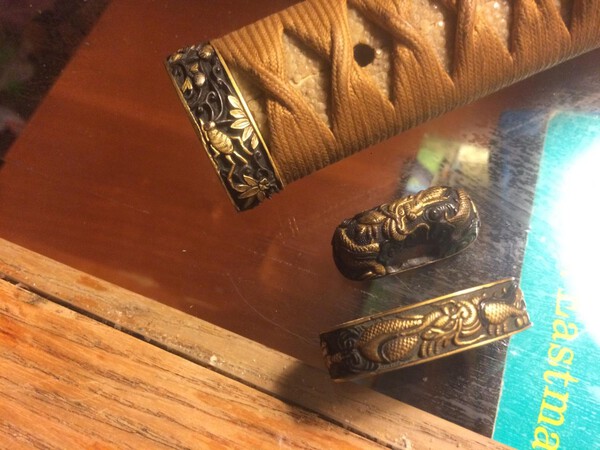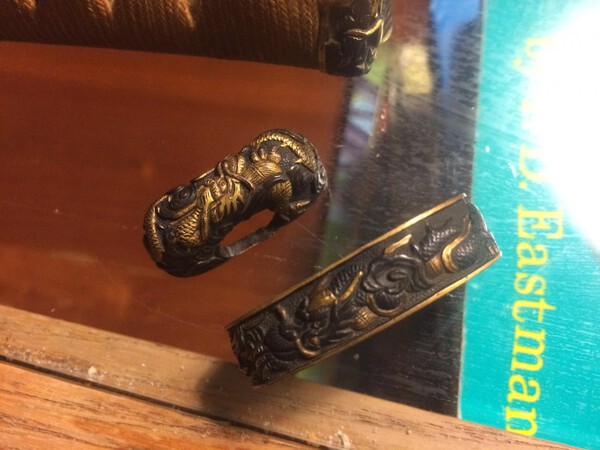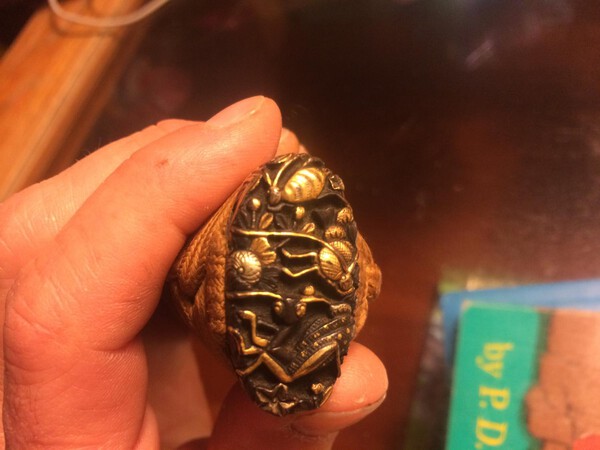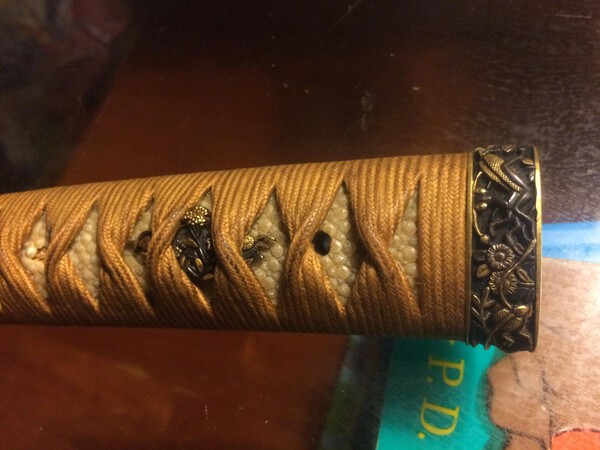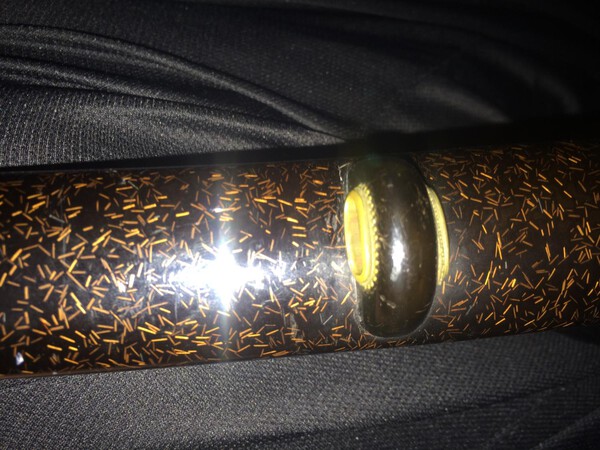-
Posts
456 -
Joined
-
Last visited
-
Days Won
4
Content Type
Profiles
Forums
Events
Store
Downloads
Gallery
Everything posted by ggil
-
All my items but the yari, and a nice copper tsuba Mr. T. Bernanrd sold me are from eBay. Most have been good deals but I've spent some serious time searching and 'watching'. The best deals are from US antiques resellers that don't specialize in nihonto as mentioned earlier. I have a really decent dragon (the fuchi has one dragon in gold and one in shakudo, with clouds) F/K set that I paid $55 for a couple years ago that I'll post this evening. They were covered in verdigris when they arrived. Also a decent koshirae that I paid $400 for from a well known Japanese eBay seller that often has much junk. the mino Tsuka and the saya pine needle lacquer inlay are quite nice. I'll post pics of This Stuff, This evening after work. eBay is the place for me but the better my collection gets the less I want to buy on eBay. It just takes too much time to find the OK items. Also I have certain examples now so less things there to get me exited about. Plus I'm just ignoring all the medium grade (low end for many here) stuff and bottom feeding. If you guys wanna see my best deal check out the 7 lucky gods tsuba I found for $1000 (started a topic here that lead to its glorious restoration).
-
By definition mei removal is hard to see. I think I see suriage Maybe a few inches, but if so it was don long ago. Maybe the infamous breaking at the original mekugi Ana, as this was common I think. Sut up... steve's post had me laughing, but Christian's posts and his playful use of English usually do the same. ????
-
Joe, follow your heart! Get in touch with a real polisher such as Mr. Worham suggests. You can do anything you set your heart and mind to do.
-
It's probably just the photos. Useful befor and after pics would have same lighting, orientation and everything. As is, the photos make it seem like the hada got opened up in the shinogi ji, because we have no before on this spot of the blade in similar light at least. Then we have Kunitaro San that mentioned here of the fujishiro famous acid polishing a showato in a day, VS the other method for no acid, so there you go.
-

Restoration Of Tosogu, Nihonto, Etc...
ggil replied to Steve Waszak's topic in General Nihonto Related Discussion
The painting was helped a lot by this restoration. I like the color in her face now, whereas before the layers of old varnish and dirt obscured the artist's work. the painting not only looks much better, it grew maybe 5% in size as the artist originally intended it,, and had its paint bonded back down to the canvas which will hopefully prolong it also. A good restorer would probably be of service to Most antiques. That seems like a lot of work to fix the painting. I'm curious to see a tosugu restorer put their methods on display like this, or would that do more harm than good (as there are more tsuba than 300 year old paintings for non-expert people to ruin)? -
For those young collectors with kids (got a 10 year old), ideally we would involve them with collecting if they show Interest. Luckily we collect things that have a universal appeal, I think. Anyway, my kid came with me to last months NCJSC meeting. She has been eyeballing all my swords especially my navy dirk with its koshirae and I've told her it's hers when she gets her bluebelt in BJJ (which will likely take her a solid 8 years, as these things generally aren't given to kids). She has been taught to respect the swords and bow to them (she doesn't get it of course yet). At the meeting she wouldn't dare touch any blades on the table even though she knows how to safely handle nihonto. I am hopeful to pass my love and respect of nihonto on to her. Maybe someday she will even want to be a polisher or smith. We can dream! Other than that I plan on giving away my pieces not selling them, and to folks who I know will carry on preserving them. My collection is low end though, if I had medium grade stuff the monitary value would probably encourage selling rather than just giving away. These swords would be a big responsibility that I may not want to put on my kid or friends.
-
Met Grey very briefly at the SF show and he seemed like a standup gentleman, who really enjoys this affliction. His site has some great prices upon gleaning through recently. Keep up the good work Mr. Doffin!
-
It Kauai, anyone would.
-
Thanks for all the info past and present contributors.
-
Pitting isn't bad then the polisher needn't cut too deep I don't think. If I was a polisher I wouldn't touch the horimono. They aren't Hallam San after all. Seriously if the dragon isn't red and rusting then they should leave it alone and let the dark contrast to the light and pop, imo. Nakago looks to have lost some patina and is rusting.
-
Oh yeah that's right you are in Samoa now. Had an 8 month stay there when I was 17 (Western Samoa). Very beautiful! Lots of Mormons (edit: the place I was at - like a reject boarding school for screwed up kids - was run by LDS, so I assumed everyone on the island was LDS. My mistake, it's actually a small percent: ~12). Sorry bout that.) Samoa has the most glorious sunsets, sunrise, and starlight of anywhere. It's marvelous.
-
Very kind of you to help Jamie out like that Steve. Must be nice living near Mr. Benson, and the islands generally speaking. Mr. Benson would have to make room for a cot for me, if I lived there:) Anyway, good form pal!
-
Ed, please help me out: anchor stamp is usually on the stainless blades which didn't take a temper (hamon) right? Yours seems to have a hamon, so some weren't stainless it seems... thanks, -Grant
-

Noshu Seki Ju Kojima Katsumasa Saku
ggil replied to cisco-san's topic in Auctions and Online Sales or Sellers
And I thought a hot stamp tends to signify hand made. On that note note, I know that current consensus is that stamps other than star indicate non traditional making (exceptions happening but rarely), but I wonder what has given past persons the idea that these were only acceptance stamps (but didn't infer anything more than acceptable work ready to further process)??? Was it the rare ones with all the makings of nihonto and still stamped, alone? Was there other indications that lead researchers (if they can be called that) to conceive this (what is now an ill-notion)? Honesty while not a popular notion, I wonder if the definition of art v Weapons have driven this, in Japan. When did the attitude of pride in ones gunto shift to shame? Was it a decision made out of the necessity of preserving culture/traditions? After WW2 educated folks must've seen the value keeping to old Japanese tradions and the costs of fully embracing western methods (colonialism and cut rate mass manufacturing). I wonder if it is just a call made to preserve the value of older blades and maintain the tradition of trying to replicate koto work? I guess to know what was going on exactly in the many various factories and subcontractors we would need some sort of materials and processing details lists, but this information wasn't made public, and this was the reality of the business/art since forever: this was secret info. -
27.5" is on the longer side isn't it? Would that drive the price up?
-
Bruce my man, to not sharpen the lower few inches of a blade is standard operating procedure since shinshinto (the only ones left in the first polish). This is the easiest kantei point: if the whole blade isn't sharp its shinshinto or later! I think if the whole thing isn't sharp we are talking about too much sake, just like you imagined
-
seller states ububa, so I thought the polish was original. I will amend my statement above to reflect that UBUBA means unsharpened lower edge, but not necessarily the FIRST polish. Thanks Grey!
-
Very nice looking and quite a large looking katana. What isn't to love about it? 80 year old polish still going strong (a guess based on UBUBA, but this may have had other polishes just not significant enough to have needed to grind deeply at the lower edge). No idea on the value, but we will know in a day or so when it sells. In my experience this seller has decent to good items. They do sell much showa era items, and this can be a minefield as you may never know for sure how traditionally made the piece is. I won an auction from this seller a long time ago, and then in communication the seller couldn't/wouldn't state whether the piece was traditionally forged or not. I balked and they refunded immediately (hadn't shipped yet). I'm a bad buyer or they are a decent seller, or some combination of the 2. I really haven't heard or cant recall hearing too many bad things about this seller.
-
Kroil and yield are good penetrating lubes but use sparingly (but do use), and tap vigorously (with something that won't do damage), to loosen bonds and allow the lube to wick. Didn't look at the photo, just wanted to share some general advice from working with old industrial equipment in heavy corrosion environments.
-
Those pictures don't say too much. Especially about the hamon running off - no way to tell yeah or nay from those. I'd be shocked if there is no munemachi, that would be odd indeed. Thickness/motogasane and variance from motogasane to nakago kasane? I think I see both ha and mune machi there (munemachi is quite small though). Agreed that the polisher should know better. Who you commissioning polish from? The mei looks to be standing quite proudly on such a old and maybe tired blade (maybe later addition???). Best of luck to you,
-
Is it unusual to fill kanji w gold on blades? Not really. It's usually done for cutting test inscriptions. But honestly, yeah pretty much everything about the piece is unusual. I wonder about the sugata of the blade... usually a Ken will slightly taper out in both kasane and haba towards the end. The piece doesn't look to have incorporated this (hard to make) trait. Is it a little fatter at the end at all? It's a lack of elegance that makes the piece less desireable (but still nice and desirable), but it does also bring doubt as to the actual steel quality and hamon hardness, etc. enjoy it, as I probably would too!
-
Looks koto, where in time does the mei place it, or were there many smiths singing thusly? I see plenty of nei near kissaki but can't see if it persists or is here and there. Looks like pretty good shape as I don't see any big flaws. It would be good to know how thick it is to help educate my guess maybe. Hopefully it isn't too tired. The skin looks good though. Looks like an nice blade that may warrant a polish. I've read that the best blades are nioi and not nie based. Anyone heard something like this? Probably just a generalization. Good luck learning more about it! People here have the knowledge and the books on hand to look up the maker/school, and these folks are very helpful. Some smiths are more obscure though. AOI has a 3rd gen kanewaka up right now for sale, w TH kantesho. Check it out!
-
Josh, maybe under all the rust it's beautiful, but as is it would have to be a great price to buy it. It needs a polish pretty badly, and we know that isn't cheap. I don't go the " uchiko till your uchiko balls fall off" route so for most this wouldn't be desirable.
-
It isn't fake, don't worry. Maybe a tourist piece but then again the blade shows suguha hamon (even tourist pieces/post sword ban stuff can be quite nice). PM one of our Japanese members like Mr. Morita San for the kanji. I like the dragon (edit: ugh I've seen worse but these were showato/late - hey it isn't polished away and it is more enjoyable than some). It looks like the kanji were Gold filled at one point. It's funny with nihonto purists that anything not exactly looking like a nihonto is always (edit: dumb generalization: many many fakes come through and people here are knowledable enough to see them mostly - sorry folks) "fake" on the board here (LOL). Then again some educated collectors still like the late oddball stuff.


